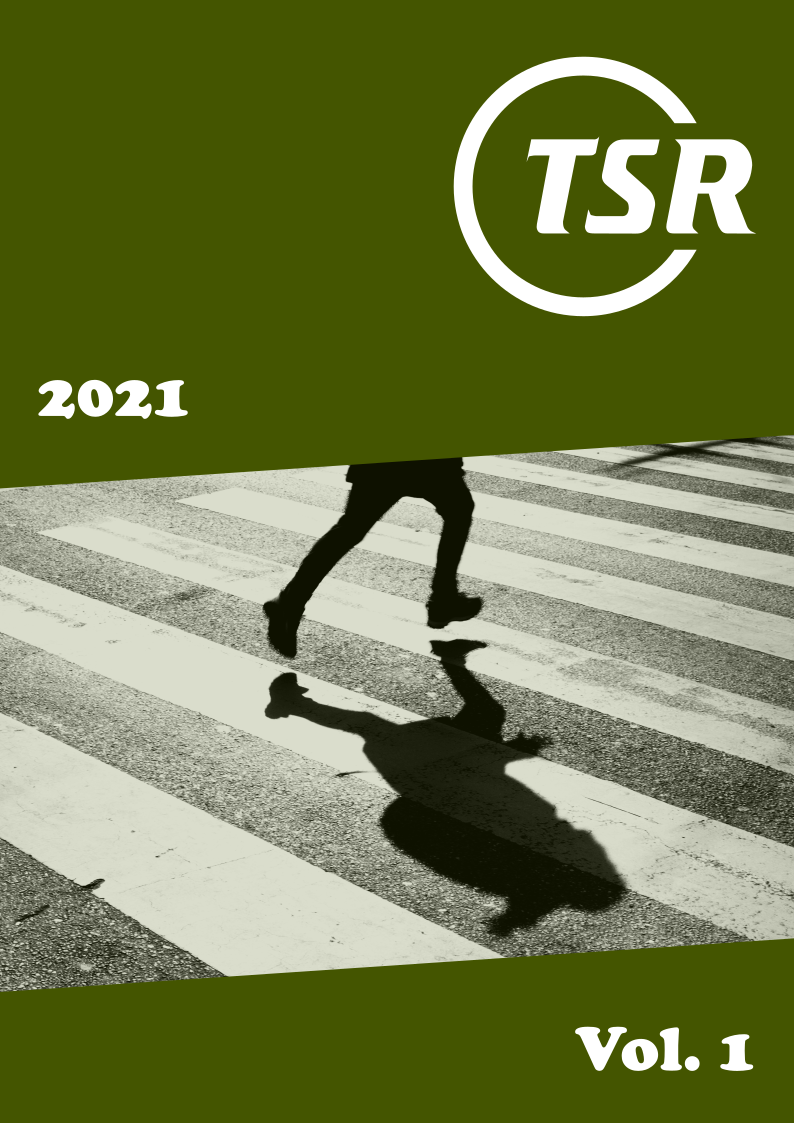Modelling self-reported driver perspectives and fatigued driving via deep learning
DOI:
https://doi.org/10.55329/galf7789Keywords:
driver fatigue, fatigue detection, multi-country survey, deep learning, binary logistic regressionAbstract
Driving while fatigued is a considerably understudied risk factor contributing to car crashes every year. The first step in mitigating the respective crash risks is to attempt to infer fatigued driving from other parameters, in order to gauge its extend in road networks. The aim of this study is to investigate the extent to which declared fatigued driving behavior can be predicted based on overall driver opinions and perceptions on that issue. For that purpose, a broad cross-country questionnaire from the ESRA2 survey was used. The questionnaire is related to self-declared beliefs, perception, and attitudes towards a wide range of traffic safety topics. Initially, a binary logistic regression model was trained to provide causal insights on which variables affect the likelihood that a driver engaged in driving while fatigued. Drivers reporting driving under the influence of drugs, fatigue, or alcohol, as well as speeding, safety, and texting while driving or drivers who were more acceptable of fatigued driving were more likely to have recently driven while fatigued. In contrast, acceptability of other hazardous behaviors, namely mobile phone use and drunk driving, was negatively correlated with fatigued driving behavior, as were more responsible driver perspectives overall. To provide a more accurate detection mechanism, which would also incorporate non-linear effects, a Deep Neural Network (DNN) was subsequently trained on the data, slightly outperforming the binary logistic model. From the results of both models, it was concluded that declared fatigued driving behavior can be predicted from questionnaire data, providing new insights to fatigue detection.
Downloads
References
Aloi, A., Alonso, B., Benavente, J., Cordera, R., Echániz, E., González, F., ... & Sañudo, R. (2020) Effects of the COVID-19 lockdown on urban mobility: empirical evidence from the city of Santander (Spain). Sustainability, 12(9), p. 3870 https://doi.org/10.3390/su12093870 DOI: https://doi.org/10.3390/su12093870
Arnold, T. B. (2017) kerasR: R interface to the keras deep learning library. Journal of Open Source Software, 2(14), 296 https://doi.org/10.21105/joss.00296 DOI: https://doi.org/10.21105/joss.00296
Backer-Grøndahl, A., & Sagberg, F. (2011) Driving and telephoning: Relative accident risk when using hand-held and hands-free mobile phones. Safety Science, 49(2), pp. 324-330 https://doi.org/10.1016/j.ssci.2010.09.009 DOI: https://doi.org/10.1016/j.ssci.2010.09.009
Bates, D., Maechler, M., Bolker, B., Walker, S., Christensen, R. H. B., Singmann, H., ... & Grothendieck, G. (2011) Package ‘lme4’. Linear mixed-effects models using S4 classes. R package version, 1(6) http://dk.archive.ubuntu.com/pub/pub/cran/web/packages/lme4/lme4.pdf
Beck, K.H., Lee, C.J. and Weiner, T. (2018) Motivational factors associated with drowsy driving behavior: a qualitative investigation of college students. Sleep Health, 4(1), pp.116-121 https://doi.org/10.1016/j.sleh.2017.10.007 DOI: https://doi.org/10.1016/j.sleh.2017.10.007
Dawson, C. W., & Wilby, R. (1998) An artificial neural network approach to rainfall-runoff modelling. Hydrological Sciences Journal, 43(1), pp. 47-66. https://doi.org/10.1080/02626669809492102 DOI: https://doi.org/10.1080/02626669809492102
Feldhütter, A., Gold, C., Schneider, S., & Bengler, K. (2016) How the Duration of Automated Driving Influences Take-Over Performance and Gaze Behavior. Advances in Ergonomic Design of Systems, Products and Processes, pp. 309–318 https://doi.org/10.1007/978-3-662-53305-5_22 DOI: https://doi.org/10.1007/978-3-662-53305-5_22
Feng, R., Zhang, G., & Cheng, B. (2009) An on-board system for detecting driver drowsiness based on multi-sensor data fusion using Dempster-Shafer theory. In 2009 International Conference on Networking, Sensing and Control (pp. 897-902). IEEE. https://doi.org/10.1109/ICNSC.2009.4919399 DOI: https://doi.org/10.1109/ICNSC.2009.4919399
Goldenbeld, C., Torfs, K., Vlakveld, W., & Houwing, S. (2020) Impaired driving due to alcohol or drugs: International differences and determinants based on E-Survey of Road Users' Attitudes first-wave results in 32 countries. IATSS Research, 44(3), pp. 188–196 https://doi.org/10.1016/j.iatssr.2020.07.005 DOI: https://doi.org/10.1016/j.iatssr.2020.07.005
Gonçalves, J., Happee, R., & Bengler, K. (2016) Drowsiness in conditional automation: proneness, diagnosis and driving performance effects. In 2016 IEEE 19th International Conference on Intelligent Transportation Systems (ITSC) (pp. 873-878). IEEE. https://doi.org/10.1109/ITSC.2016.7795658 DOI: https://doi.org/10.1109/ITSC.2016.7795658
Grossman, E.S., & Rosenbloom, T. (2016) Perceived level of performance impairment caused by alcohol and restricted sleep. Transportation Research Part F, 41: pp. 113–123 https://doi.org/10.1016/j.trf.2016.06.002 DOI: https://doi.org/10.1016/j.trf.2016.06.002
Gulli, A., & Pal, S. (2017) Deep learning with Keras. Packt Publishing Ltd. ISBN: 978-1-78712-842-2.
Hara, K., Saito, D., & Shouno, H. (2015) Analysis of function of rectified linear unit used in deep learning. In 2015 IEEE International Joint Conference on Neural Networks (IJCNN) (pp. 1-8). https://doi.org/10.1109/IJCNN.2015.7280578 DOI: https://doi.org/10.1109/IJCNN.2015.7280578
Harrell, F. E. (2015) Binary logistic regression. In Harrell, F. E. Regression modeling strategies (pp. 219-274). Springer, Cham. ISBN: 978-3-319-19425-7. https://doi.org/10.1007/978-3-319-19425-7 DOI: https://doi.org/10.1007/978-3-319-19425-7_10
Hosmer DW, Lemeshow S. (1989) Applied logistic regression. New York: John Wiley & Son. ISBN: 9781118548387. https://doi.org/10.1002/9781118548387 DOI: https://doi.org/10.1002/9781118548387
Jackson, P., Hilditch, C., Holmes, A., Reed, N., Merat, N. and Smith, L., (2011) Fatigue and road safety: a critical analysis of recent evidence. UK Department for Transport, Road Safety Web Publication, 21. ISBN: 978-1-84864-110-5.
Khan M.I., Mansoor A.B. (2008) Real Time Eyes Tracking and Classification for Driver Fatigue Detection. In: Campilho A., Kamel M. (eds) Image Analysis and Recognition. ICIAR 2008. Lecture Notes in Computer Science, vol 5112. Springer, Berlin, Heidelberg. https://doi.org/10.1007/978-3-540-69812-8_72 DOI: https://doi.org/10.1007/978-3-540-69812-8_72
Kong, W., Zhou, L., Wang, Y., Zhang, J., Liu, J. and Gao, S., (2015) A system of driving fatigue detection based on machine vision and its application on smart device. Journal of Sensors, 2015. https://doi.org/10.1155/2015/548602 DOI: https://doi.org/10.1155/2015/548602
Li, R., Chen, Y. V., & Zhang, L. (2021) A method for fatigue detection based on Driver's steering wheel grip. International Journal of Industrial Ergonomics, 82, 103083. https://doi.org/10.1016/j.ergon.2021.103083 DOI: https://doi.org/10.1016/j.ergon.2021.103083
Li, K., Gong, Y., & Ren, Z. (2020) A fatigue driving detection algorithm based on facial multi-feature fusion. IEEE Access, 8, pp. 101244-101259 https://doi.org/10.1109/ACCESS.2020.2998363 DOI: https://doi.org/10.1109/ACCESS.2020.2998363
Li, Z., Chen, L., Peng, J., & Wu, Y. (2017) Automatic Detection of Driver Fatigue Using Driving Operation Information for Transportation Safety. Sensors, 17(6), p. 1212 https://doi.org/10.3390/s17061212 DOI: https://doi.org/10.3390/s17061212
Meesmann, U., Torfs, K., Wardenier, N. & Van den Berghe, W. (2021) ESRA2 methodology. ESRA2 report Nr. 1 (updated version). ESRA project (E-Survey of Road users’ Attitudes). Brussels, Belgium: Vias institute. Available: https://www.esranet.eu/storage/minisites/esra2-methodology-report-updatewave2-def.pdf
Miyata, S., Noda, A., Ozaki, N., Hara, Y., Minoshima, M., Iwamoto, K., Takahashi, M., Iidaka, T., & Koike, Y. (2010) Insufficient sleep impairs driving performance and cognitive function. Neuroscience letters, 469(2), pp. 229–233 https://doi.org/10.1016/j.neulet.2009.12.001 DOI: https://doi.org/10.1016/j.neulet.2009.12.001
Nordbakke, S., & Sagberg, F. (2007) Sleepy at the wheel: Knowledge, symptoms and behaviour among car drivers. Transportation Research Part F: Traffic Psychology and Behaviour, 10(1), pp. 1–10 https://doi.org/10.1016/j.trf.2006.03.003 DOI: https://doi.org/10.1016/j.trf.2006.03.003
Parsa, M.J., Javadi, M. and Mazinan, A.H. (2021) Fatigue level detection using multivariate autoregressive exogenous nonlinear modeling based on driver body pressure distribution. Proceedings of the Institution of Mechanical Engineers, Part D: Journal of Automobile Engineering, p. 09544070211014290 https://doi.org/10.1177/09544070211014290 DOI: https://doi.org/10.1177/09544070211014290
Pires, C., Torfs, K., Areal, A., Goldenbeld, C., Vanlaar, W., Granie, M.A., Stürmer, Y.A., Usami, D.S., Kaiser, S., Jankowska-Karpa, D. and Nikolaou, D. (2020) Car drivers' road safety performance: A benchmark across 32 countries. IATSS research, 44(3), pp.166-179 https://doi.org/10.1016/j.iatssr.2020.08.002 DOI: https://doi.org/10.1016/j.iatssr.2020.08.002
R Core Team (2019) R: A language and environment for statistical computing. R Foundation for Statistical Computing, Vienna, Austria. URL: https://www.R-project.org/.
Radun, I., Radun, J., Wahde, M., Watling, C.N. and Kecklund, G. (2015) Self-reported circumstances and consequences of driving while sleepy. Transportation Research Part F: Traffic Psychology And Behaviour, 32, pp. 91-100 https://doi.org/10.1016/j.trf.2015.05.004 DOI: https://doi.org/10.1016/j.trf.2015.05.004
Ribeiro, M. T., Singh, S., & Guestrin, C. (2016) "Why should I trust you?" Explaining the predictions of any classifier. In Proceedings of the 22nd ACM SIGKDD international conference on knowledge discovery and data mining, pp. 1135-1144 https://doi.org/10.1145/2939672.2939778 DOI: https://doi.org/10.1145/2939672.2939778
Samarasinghe, S. (2006) Neural Networks For Applied Sciences And Engineering: From Fundamentals To Complex Pattern Recognition. CRC Press. ISBN 9780849333750
Sayed, R., & Eskandarian, A. (2001) Unobtrusive drowsiness detection by neural network learning of driver steering. Proceedings of the Institution of Mechanical Engineers, Part D: Journal of Automobile Engineering, 215(9), pp. 969–975 https://doi.org/10.1243/0954407011528536 DOI: https://doi.org/10.1243/0954407011528536
Schmidhuber, J. (2015) Deep learning in neural networks: An overview. Neural networks, 61, pp. 85-117 https://doi.org/10.1016/j.neunet.2014.09.003 DOI: https://doi.org/10.1016/j.neunet.2014.09.003
Sikander, G., & Anwar, S. (2018) Driver fatigue detection systems: A review. IEEE Transactions on Intelligent Transportation Systems, 20(6), pp. 2339-2352 https://doi.org/10.1109/TITS.2018.2868499 DOI: https://doi.org/10.1109/TITS.2018.2868499
Singh, S. (2018) Critical reasons for crashes investigated in the National Motor Vehicle Crash Causation Survey. (Traffic Safety Facts Crash Stats. Report No. DOT HS 812 506). Washington, DC: U.S. National Highway Traffic Safety Administration.
Singh, S. (2015) Critical reasons for crashes investigated in the National Motor Vehicle Crash Causation Survey. NHTSA Report (No. DOT HS 812 115).
Smolensky, M. H., Di Milia, L., Ohayon, M. M., & Philip, P. (2011) Sleep disorders, medical conditions, and road accident risk. Accident Analysis and Prevention, 43(2), pp. 533–548 https://doi.org/10.1016/j.aap.2009.12.004 DOI: https://doi.org/10.1016/j.aap.2009.12.004
Talbot, R., Filtness. A. (2017) Fatigue – Not Enough Sleep/Driving While Tired, European Road Safety Decision Support System, developed by the H2020 project SafetyCube. Retrieved from www.roadsafety-dss.eu on 11 June 2021
Tefft, B.C. (2010) Asleep at the wheel: The prevalence and impact of drowsy driving. AAA Foundation for Traffic Safety. Available: https://aaafoundation.org/wp- content/uploads/2018/02/2010DrowsyDrivingReport.pdf
Torfs, K., Meesmann, U., Van den Berghe, W., & Trotta, M. (2016) ESRA 2015 – The results. Synthesis of the main findings from the ESRA survey in 17 countries. ESRA project (European Survey of Road users’ safety Attitudes). Brussels, Belgium. Available: https://www.esranet.eu/storage/minisites/esra2017-en.pdf
Tranmer, M., & Elliot, M. (2008) Binary logistic regression. Cathie Marsh for census and survey research, paper, 20. Available: http://hummedia.manchester.ac.uk/institutes/cmist/archive-publications/working-papers/2008/2008-20-binary-logistic-regression.pdf
United States National Sleep Foundation (2013) 2013 International Bedroom Poll: https://www.sleepfoundation.org/professionals/sleep-americar-polls/2013-international-bedroom-poll (Accessed 11 June 2021)
United States Federal Motor Carrier Safety Administration (FMCSA) (2011) Hours of service of drivers. U.S. Federal Register, vol. 76(248)
United States National Center for Statistics and Analysis (NCSA). (2020) Overview of motor vehicle crashes in 2019. (Traffic Safety Facts Research Note. Report No. DOT HS 813 060). National Highway Traffic Safety Administration (NHTSA).
Vanlaar, W., Simpson, H., Mayhew, D., & Robertson, R. (2008) Fatigued and drowsy driving: A survey of attitudes, opinions and behaviors. Journal of Safety Research, 39(3), pp. 303-309 https://doi.org/10.1016/j.jsr.2007.12.007 DOI: https://doi.org/10.1016/j.jsr.2007.12.007
Wang, M. S., Jeong, N. T., Kim, K. S., Choi, S. B., Yang, S. M., You, S. H., ... & Suh, M. W. (2016) Drowsy behavior detection based on driving information. International Journal of Automotive Technology, 17(1), pp. 165-173. https://doi.org/10.1007/s12239-016-0016-y DOI: https://doi.org/10.1007/s12239-016-0016-y
Wang, S.C. (2003) Artificial Neural Network in Wang, S.C., Interdisciplinary Computing in Java Programming, 81–100. ISBN: 978-1-4615-0377-4. https://doi.org/10.1007/978-1-4615-0377-4_5 DOI: https://doi.org/10.1007/978-1-4615-0377-4_5
Washington, S., Karlaftis, M. G., Mannering, F., & Anastasopoulos, P. (2020) Statistical and Econometric Methods for Transportation Data Analysis. CRC Press. ISBN: 9780429244018. https://doi.org/10.1201/9780429244018 DOI: https://doi.org/10.1201/9780429244018
Watling, C.N., Armstrong, K.A., Obst, P.L. and Smith, S.S., (2014) Continuing to drive while sleepy: The influence of sleepiness countermeasures, motivation for driving sleepy, and risk perception. Accident Analysis & Prevention, 73, pp.262-268 https://doi.org/10.1016/j.aap.2014.09.021 DOI: https://doi.org/10.1016/j.aap.2014.09.021
Watling, C.N. (2014) Sleepy driving and pulling over for a rest: Investigating individual factors that contribute to these driving behaviours. Personality and Individual Differences, 56, pp. 105-110 https://doi.org/10.1016/j.paid.2013.08.031 DOI: https://doi.org/10.1016/j.paid.2013.08.031
Wilson, R.J., Fang, M., Cooper, P.J. and Beirness, D.J. (2006) Sleepiness among night-time drivers: relationship to blood alcohol concentration and other factors. Traffic Injury Prevention, 7(1), pp. 15-22 https://doi.org/10.1080/15389580500412929 DOI: https://doi.org/10.1080/15389580500412929
World Health Organization – WHO. (2018) Global status report on road safety 2018. ISBN: 9789241565684. Available: https://www.who.int/violence_injury_prevention/road_safety_status/2018/en/
Yannis, G., Nikolaou, D., Laiou, A., Stürmer, Y. A., Buttler, I., & Jankowska-Karpa, D. (2020) Vulnerable road users: Cross-cultural perspectives on performance and attitudes. IATSS Research, 44(3), pp. 220–229 https://doi.org/10.1016/j.iatssr.2020.08.006 DOI: https://doi.org/10.1016/j.iatssr.2020.08.006
Zhang, C., Wang, H., & Fu, R. (2014) Automated Detection of Driver Fatigue Based on Entropy and Complexity Measures. IEEE Transactions on Intelligent Transportation Systems, 15(1), pp. 168–177 https://doi.org/10.1109/tits.2013.2275192 DOI: https://doi.org/10.1109/TITS.2013.2275192
Zhang, G., Yau, K. K., Zhang, X., & Li, Y. (2016) Traffic accidents involving fatigue driving and their extent of casualties. Accident Analysis & Prevention, 87, pp. 34-42 https://doi.org/10.1016/j.aap.2015.10.033 DOI: https://doi.org/10.1016/j.aap.2015.10.033
Zhou, F., Alsaid, A., Blommer, M., Curry, R., Swaminathan, R., Kochhar, D., Talamonti, W., Tijerina, L., & Lei, B. (2020) Driver fatigue transition prediction in highly automated driving using physiological features. Expert Systems with Applications, 147, p. 113204 https://doi.org/10.1016/j.eswa.2020.113204 DOI: https://doi.org/10.1016/j.eswa.2020.113204
Zou, X., Yue, W. L., & Le Vu, H. (2018) Visualization and analysis of mapping knowledge domain of road safety studies. Accident Analysis & Prevention, 118, pp. 131-145 https://doi.org/10.1016/j.aap.2018.06.010 DOI: https://doi.org/10.1016/j.aap.2018.06.010
Ziakopoulos, A., Theofilatos, A., Laiou, A., Michelaraki, E., Yannis, G., & Rosenbloom, T. (2021a) Examining the relationship between impaired driving and past crash involvement in Europe: Insights from the ESRA study. International Journal of Injury Control and Safety Promotion, pp. 1–11 https://doi.org/10.1080/17457300.2021.1928234 DOI: https://doi.org/10.1080/17457300.2021.1928234
Ziakopoulos, A., Nikolaou, D., & Yannis, G. (2021b) Correlations of multiple rider behaviors with self-reported attitudes, perspectives on traffic rule strictness and social desirability. Transportation Research Part F: Traffic Psychology and Behaviour, 80, pp. 313–327 https://doi.org/10.1016/j.trf.2021.05.011 DOI: https://doi.org/10.1016/j.trf.2021.05.011
Downloads
Published
How to Cite
Issue
Section
License
Copyright (c) 2021 Alexandros Zoupos, Apostolos Ziakopoulos, George Yannis

This work is licensed under a Creative Commons Attribution 4.0 International License.










